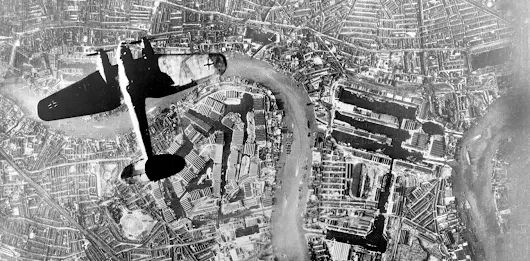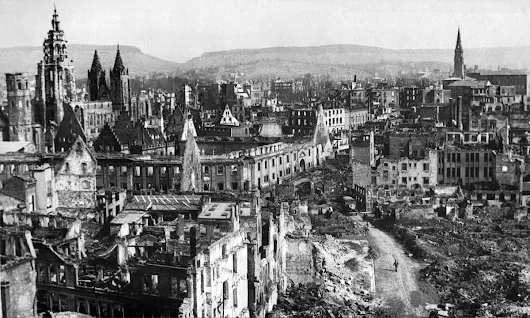What was the Blitz and could it have won WW2 for Germany? - IWM > .
2022 - Special Douhetesque Blunder ..
Bombing Germany, Japan ..
Bombing Runs - RFC to RAF ..
Vergeltungswaffe 1 & Spitfire ..
Vergeltungswaffe 2 & America Space Rockets ..
Coventry ..
Heilbronn bombing ..
Hull Blitz ..
Industrial Targets - Britain ..
Leeds Blitz ..
Liverpool Blitz ..
40-12-30 Second Great Fire of London ..
London Blitz ..
Hull Blitz ..
Industrial Targets - Britain ..
Leeds Blitz ..
Liverpool Blitz ..
40-12-30 Second Great Fire of London ..
London Blitz ..
London - April 11, 1941 ..
London, Balham Tube station ..
London docklands - Blitz ..
London Hospital, St Thomas Hospital - Blitz ..
London Blitz - West End ..
London - Blitz Through Time ..
London - Parliament Bombed ..
Manchester Blitz ..
Parachute Mines ..
Rotterdam bombed by USAF - 43-3-31 ..
London, Balham Tube station ..
London docklands - Blitz ..
London Hospital, St Thomas Hospital - Blitz ..
London Blitz - West End ..
London - Blitz Through Time ..
London - Parliament Bombed ..
Manchester Blitz ..
Scotland's Blitz ..
Sheffield Blitz ..
Southampton Blitz ..
40-10-17 St Paul's Bombed ..
Strategic Bombing - RvsU ..
UXBs & Bomb Disposal Companies ..Sheffield Blitz ..
Southampton Blitz ..
40-10-17 St Paul's Bombed ..
Strategic Bombing - RvsU ..
Vergeltungswaffe 1 & Spitfire ..
Vergeltungswaffe 2 & America Space Rockets ..
Yorkshire - Bombed ..
Birmingham . Bradford . Brighton . Coventry . Croydon . Leeds . Liverpool . London . London, Balham Tube Station . Plymouth . Southampton . York .
Blitz, WW2 ..
The 'Blitz' – from the German term Blitzkrieg ('lightning war') – was the sustained campaign of aerial bombing attacks on British towns and cities carried out by the Luftwaffe (German Air Force) from September 1940 until May 1941.
The Blitz began on 7 September, 'Black Saturday', when German bombers attacked London, leaving 430 dead and 1,600 injured. London was then bombed for 57 consecutive nights, and often during daytime too. London experienced regular attacks and on 10-11 May 1941 was hit by its biggest raid. German bombers dropped 711 tons of high explosive and 2,393 incendiaries. 1,436 civilians were killed. However, this proved to be the last major raid until January 1943.
While London was bombed more heavily and more often than anywhere else in Britain, the Blitz was an attack on the whole country. Very few areas were left untouched by air raids. In relatively small compact cities, the impact of a severe air raid could be devastating.
From mid-November 1940, major provincial cities and industrial centres were targeted. In early 1941 another wave of attacks began, primarily against ports. Respite finally came from June when much of the Luftwaffe was directed against Russia and targets in the Mediterranean.
In these nine months, over 43,500 civilians were killed. This is how the Blitz affected towns and cities across the United Kingdom.
https://www.pinterest.ca/strangeblokethi/world-war-ii-the-blitz/?lp=true .
Contra-Bumbledom: "In general nothing emerges more forcibly from the Blitz than the contrast between laggard councillors, obsessed with their own prestige, and the self-sacrifice of the volunteers who strove indefatigably to remedy the position which bumbledom had created."
"Britain after the Blitz: how to rebuild a city fit for a post-conflict population"
https://theconversation.com/britain-after-the-blitz-how-to-rebuild-a-city-fit-for-a-post-conflict-population-47111 .
Agriculture | Air | Atrocities & APD | Blitz, Bombing | Campaigns | Capture | Characters | Cold War & Balance of Power | Defence | Government | Home Front | Industry | Infrastructure | Intelligence | Interbellum Years | Locations | Logistics | Occupation | Post-War Military | Post-War Power Vacuums | Propaganda, Publications | Sea | Services | Sinkings | Sociopolitical | Technology | Theatres | Timelines | Volunteers | War | Weaponry | WW1 |
Birmingham . Bradford . Brighton . Coventry . Croydon . Leeds . Liverpool . London . London, Balham Tube Station . Plymouth . Southampton . York .
Blitz, WW2 ..
The 'Blitz' – from the German term Blitzkrieg ('lightning war') – was the sustained campaign of aerial bombing attacks on British towns and cities carried out by the Luftwaffe (German Air Force) from September 1940 until May 1941.
The Blitz began on 7 September, 'Black Saturday', when German bombers attacked London, leaving 430 dead and 1,600 injured. London was then bombed for 57 consecutive nights, and often during daytime too. London experienced regular attacks and on 10-11 May 1941 was hit by its biggest raid. German bombers dropped 711 tons of high explosive and 2,393 incendiaries. 1,436 civilians were killed. However, this proved to be the last major raid until January 1943.
While London was bombed more heavily and more often than anywhere else in Britain, the Blitz was an attack on the whole country. Very few areas were left untouched by air raids. In relatively small compact cities, the impact of a severe air raid could be devastating.
From mid-November 1940, major provincial cities and industrial centres were targeted. In early 1941 another wave of attacks began, primarily against ports. Respite finally came from June when much of the Luftwaffe was directed against Russia and targets in the Mediterranean.
In these nine months, over 43,500 civilians were killed. This is how the Blitz affected towns and cities across the United Kingdom.
https://www.pinterest.ca/strangeblokethi/world-war-ii-the-blitz/?lp=true .
Contra-Bumbledom: "In general nothing emerges more forcibly from the Blitz than the contrast between laggard councillors, obsessed with their own prestige, and the self-sacrifice of the volunteers who strove indefatigably to remedy the position which bumbledom had created."
"Britain after the Blitz: how to rebuild a city fit for a post-conflict population"
https://theconversation.com/britain-after-the-blitz-how-to-rebuild-a-city-fit-for-a-post-conflict-population-47111 .
Agriculture | Air | Atrocities & APD | Blitz, Bombing | Campaigns | Capture | Characters | Cold War & Balance of Power | Defence | Government | Home Front | Industry | Infrastructure | Intelligence | Interbellum Years | Locations | Logistics | Occupation | Post-War Military | Post-War Power Vacuums | Propaganda, Publications | Sea | Services | Sinkings | Sociopolitical | Technology | Theatres | Timelines | Volunteers | War | Weaponry | WW1 |
●● Air | ●● Atrocities & APD | ●● Blitz | ●● Campaigns | ●● Capture, Occupation | ●● Characters | ●● Defence | ●● INDEX | ●● Government, Society | ●● Home Front | ●● Intelligence, Espionage | ●● Land | ●● Logistics, Tactics ● Military Training | ●● Post-War Military | ●● Post-War Power Vacuums | ●● Sea | ●● Services ● Sinkings | ● Sociopolitical Issues | ●● Technology | ●● Theatres | ●● Timeline WW2 | ●● Volunteers | ●● Weaponry |
● 1939 | ● 1940 |
39-9-3 to 41-10-20 . 41-10-20 to 43-8-18 . 43-8-19 to 45-7-7 . 45-7-8 to post-war .
● 1939 | ● 1940 |
39-9-3 to 41-10-20 . 41-10-20 to 43-8-18 . 43-8-19 to 45-7-7 . 45-7-8 to post-war .







